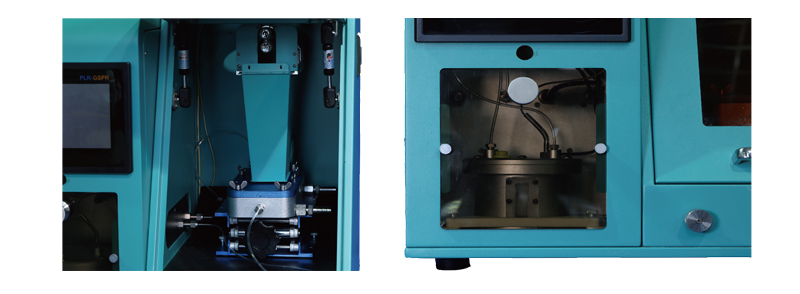In gas-solid photocatalytic CO₂ reduction experiments, the humidity of CO₂ can affect the CO₂ conversion rate and product selectivity of photocatalytic CO₂ reduction. Precise humidity control can be used to study the mechanism of water content's impact on CO₂ reduction efficiency and optimize the reaction conditions for CO₂ reduction.
The PLR-GSPR atmospheric gas-solid phase photocatalytic reaction system features an 8.5-inch LED extra-large display screen, where all operations can be completed. It offers user-friendly design for easy operation.

Figure 1. PLR-GSPR Atmospheric Gas-Solid Phase Photocatalytic Reaction System and Interface
1. Precise control of feed gas humidity
The gas distribution module in the reaction system uses high-precision intelligent control combined with humidification to precisely control the humidity of CO₂ gas in the feed gas.
2. High mass transfer efficiency
The reactor's flattened design reduces the free diffusion distance of CO₂ to the photocatalyst surface, increasing the collision probability between CO₂ and the photocatalyst and improving mass transfer efficiency.
3. Efficient gas circulation
The closed-phase reaction mode includes a gas circulation device, which enhances mass transfer in the reaction.
1. Intelligent humidity control system for precise control of water vapor content in CO₂
The PLR-GSPR atmospheric gas-solid phase photocatalytic reaction system uses program feedback control to obtain controllable humidity CO₂ gas through multi-route gas mixing. The inlet is equipped with temperature, humidity, and pressure sensors as standard and can optionally be configured with temperature, humidity, and pressure sensors at the outlet. It provides real-time monitoring of the CO₂ state in the reaction system, enabling feedback control of humidity with a humidity control range of 5~95% RH and an accuracy of ±3% RH. During experiments, simply set the humidity on the display screen, and the reaction system will automatically configure the corresponding humidity CO₂ gas to enter the reactor for the reaction.

Figure 2. PLR-GSPR Atmospheric Gas-Solid Phase Photocatalytic Reaction System Humidity Control Schematic
2. Flattened reactor design to reduce CO₂ free diffusion distance and enhance mass transfer efficiency
The reactor in the PLR-GSPR atmospheric gas-solid phase photocatalytic reaction system is designed in a flattened manner, reducing the free diffusion distance of CO₂ to the photocatalyst surface, increasing the collision probability between CO₂ gas and the photocatalyst, and enhancing mass transfer efficiency. It uses a gas-penetrating design to ensure that CO₂ gas fully contacts and reacts with the photocatalyst. The internal part of the PLR-GSPR atmospheric gas-solid phase photocatalytic reaction system has a gas circulation power source, maintaining a unidirectional gas circulation in the reaction system, effectively ensuring the mass transfer process of the reaction. The bottom of the reactor has a water-cooling temperature control groove for temperature control of the reaction system.

Figure 3. PLR-GSPR Atmospheric Gas-Solid Phase Photocatalytic Reaction System Reactor and Gas Flow Schematic

Figure 4. Participating in the Formulation of National Standard GB/T 39716-2020 "Method for Testing Nitrogen Oxide Removal of Photocatalytic Materials and Products for Air Purification"
▲ Particularly suitable ● Relatively suitable ○ Can be used
▲ Photodegradation of gas pollutants (such as VOCs, formaldehyde, nitrogen oxides, sulfur oxides, etc.)
▲ Other room-temperature and atmospheric pressure (photo) chemical reactions
○ Photocatalytic CO₂ reduction
○ Membrane photocatalysis

| Control Unit | |
| Intelligent Display | 8.5-inch LED extra-large display, visualization monitoring of the reaction process |
| Software Control | Software architecture based on the ROM framework, sensor feedback control to meet various experimental conditions |
| Control Modes | Pure gas flow, total gas flow, total reaction flow, virtual total flow |
| Independent Gas Control | 4 independent gas control routes (expandable to 8 standard gases) to meet different gas distribution needs |
| Flow Control | Mass flow controller, accuracy ±1%F.S. |
| Humidification Mode | Intelligent humidity feedback system, independent gas humidification tank |
| Humidity Control | Humidification tank humidification and sensor feedback control |
| Gas State Monitoring | Double-position detection at the inlet and outlet, humidity resolution 0.04% RH, temperature resolution 0.01°C, pressure resolution 0.016 mbar |
| Reaction Unit | |
| Reactor Specifications and Materials | 250 × 120 × 40 mm³, corrosion-resistant alloy (standard), polytetrafluoroethylene material (optional) |
| Reaction Volume | Sheet format: 50 × 100 × 5 mm³; porous media: 50 × 100 × 10 mm³ |
| Light Window | Quartz glass material, effective light window size 50 × 100 mm² |
| Reactor Temperature Control | Water cooling control at the bottom of the reactor |
| Catalyst Materials | 1. Membrane material (100 × 50 × 5 mm³, loaded on glass and other substrates) |
| 2. Bulk materials (100 × 50 × 1 ~ 10 mm³) | |
| 3. Powder (molded onto filter membrane substrates up to 100 × 50 mm²) | |
| Basic Parameters | |
| Power Parameters | 220 VAC/50 Hz, 1 A (wide voltage input, 110 ~ 260 VAC) |
| Flow Control | Accuracy ±1%F.S., repeatability ±0.5%F.S., control range 4% ~ 100%F.S., selectable range |
| Gas Flow Pressure Drop | ≤3.5 kPa (under 1 L/min flow conditions) |
| Humidity Monitoring | Range 5 ~ 95%RH (non-condensing); accuracy ±1%RH, resolution 0.1%RH |
| Temperature Monitoring | Range 5 ~ 95%RH (non-condensing); accuracy ±3%RH @ 20 ~ 80% (±5% for others), resolution 0.1%RH |
| Note: The temperature control range is related to various gas flow rates, humidification tank temperatures, and other conditions. | |
| Pressure Monitoring | Range 1 ~ 200 kPa; accuracy ±0.2 kPa, resolution 0.1 kPa |
| Liquid Level Monitoring | Liquid level height 16 mm; error ±1.5 mm |
| Equipment Selection for Detection (Different types of detection equipment can be optionally selected according to the target detection substance) | |
| Gas Chromatography | CO, CO₂, low alkanes |
| Ion Chromatography | NO₃⁻, NH₄⁺, Cl⁻, Br⁻ |
| Photoacoustic Spectrometer | Trace gas analysis, VOCs |
| Nitrogen Oxide Analyzer | NO, NO₂, NOₓ |